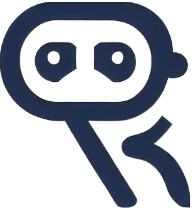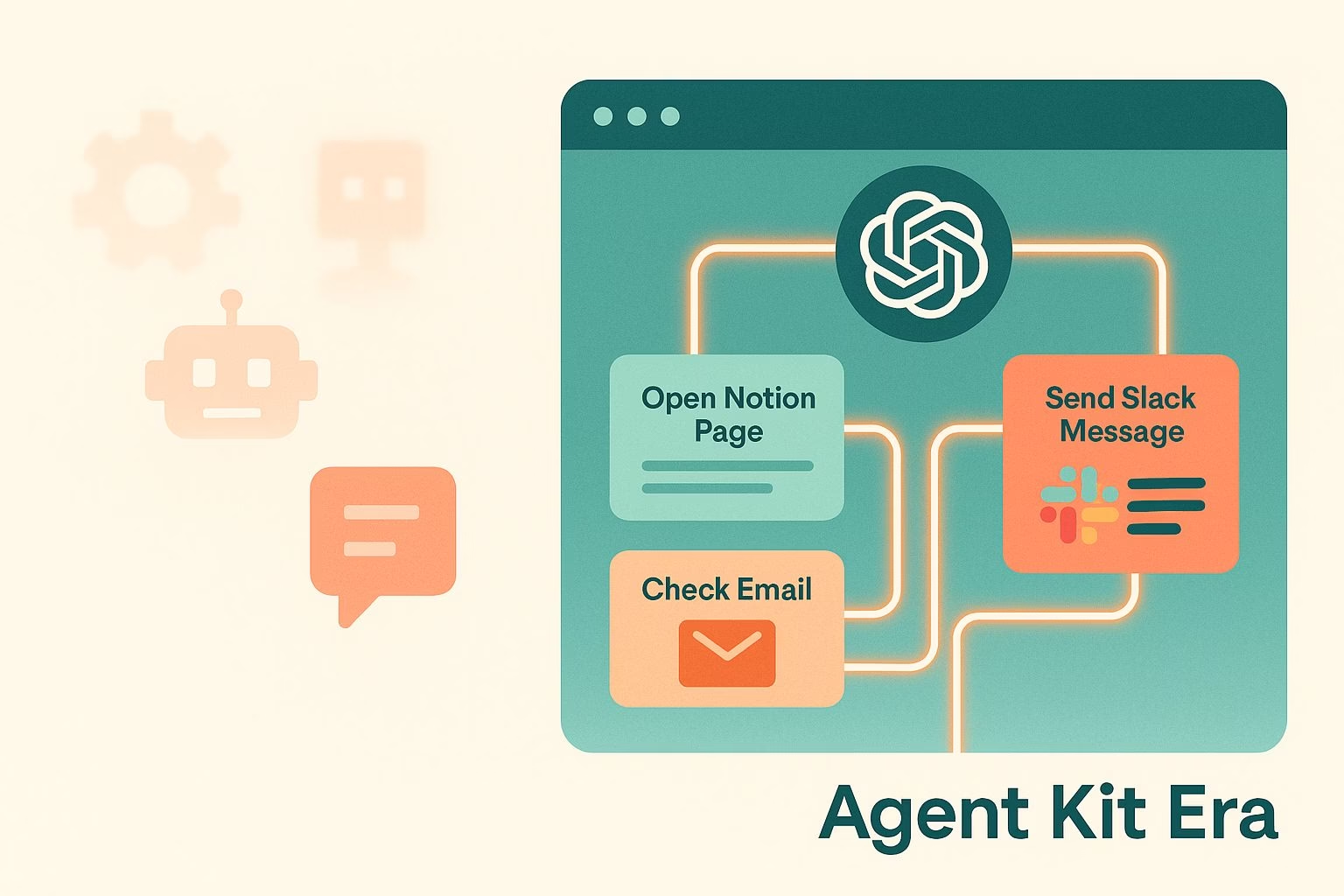OpenAI Just Quietly Killed Half the Automation Startups
Quick takeaways
- Agent Kit brings native drag and drop agents into ChatGPT, removing the need for many wrapper tools.
- Startups that rely only on the OpenAI API lose leverage. Depth, data, and human oversight keep products alive.
- Work shifts toward designing, monitoring, and auditing agents rather than wiring basic integrations.
Something major just happened, and the automation startup scene may never recover.
OpenAI released a huge update that changes how AI agents and apps work together. The new feature is called Agent Kit, which allows developers to build agents that act, rather than just chat.
With Agent Kit, you can now create agents that open Notion pages, send Slack messages, check emails, or even book appointments.
It removes the need for middle tools or wrapper apps that used to handle these actions. The setup uses drag-and-drop logic, tool connectors, and guardrails for control.
People are calling it “n8n for AI,” but with deeper integration inside ChatGPT.
This update shakes the foundation for many small automation startups that relied on connecting AI to apps. Most of them were wrappers built on top of OpenAI’s API, and now OpenAI has taken that function in-house.
Once a major platform reaches the same level of features as the tools that depend on it, those smaller tools lose their purpose.
At the same time, OpenAI also introduced:
-
Apps SDK for building apps directly inside ChatGPT
-
Sora 2 API for generating video and audio
-
o1 model focused on improved reasoning and task planning
Together, these updates turn OpenAI into a complete automation system rather than a simple foundation model.
What Agent Kit Means for Automation Startups
Agent Kit represents the point where OpenAI stops being a background service and becomes a full automation layer. It gives developers the same tools that entire startups have been selling for months.
Many small players built their companies around connecting ChatGPT to other apps. They offered easy automation dashboards, task agents, or email bots that relied on the OpenAI API.
Now, OpenAI’s own system does that out of the box.
Agents can take direct action using logic blocks, built-in connectors, and a visual workflow builder. Anyone who has used n8n or Zapier will recognize the concept, but the difference here is that OpenAI runs the full stack.
The agent does not just send requests; it thinks, plans, and executes within ChatGPT itself.
For developers and founders, this means one thing: adapt fast or fade out.
Startups that added only a light interface or minor convenience are now obsolete. The ones that survive will focus on depth, solving problems that need human judgment or specialized knowledge that generic agents cannot handle.
The irony is clear. Many founders who built “wrappers” on top of OpenAI are now seeing OpenAI wrap them instead.
The Difference Between Wrappers and Real Products
The debate about wrappers versus real products exploded right after the announcement.
In simple terms, a wrapper depends entirely on another company’s API, adding a thin interface or preset prompts. It provides convenience but not unique value.
When the parent platform copies that idea, the wrapper disappears.
A real product, on the other hand, adds its own layer of intelligence, data, or context. It connects multiple APIs, integrates with real workflows, and delivers outcomes that users rely on every day.
That distinction is why some automation tools like Zapier, CaesrAI, and Wordware might still survive. They go beyond simple prompts and handle complex orchestration that even OpenAI’s new agents cannot yet manage.
Many developers also pointed to the Model Context Protocol (MCP), an open framework that allows language models like Claude and ChatGPT to connect with multiple tools through standard servers. You can view the active integration list directly on GitHub.
As one Reddit commenter put it, everything in tech builds on someone else’s code. The key difference is whether you are reselling the foundation or creating something people truly depend on.
The startups that stay relevant will be those that use OpenAI’s tools as components, not crutches.
Why OpenAI’s Update Was Inevitable
Every major platform eventually absorbs the best ideas built around it. It happened with Google, Facebook, and Amazon, and it is now happening with OpenAI.
Once a company becomes the foundation for thousands of tools, it begins to see what works best and integrates those ideas into its own core.
Automation startups made this easy. Many were built on top of OpenAI’s API with minimal differentiation. They offered the same services that users could achieve with a few lines of code.
Once OpenAI realized how common these workflows were, it simply built them in. The moment the base layer reaches that point, the wrappers lose all leverage.
This pattern repeats across tech history. Google Search killed dozens of SEO tools by building its features directly into its dashboard.
Facebook crushed third-party page managers when it launched its own suite. OpenAI’s move is the same kind of consolidation.
The market gets smaller, but the surviving products grow stronger.
That is why Agent Kit and the Apps SDK were inevitable. OpenAI is not trying to destroy startups; it is pulling their best work into its ecosystem to give users a complete experience inside ChatGPT.
Where Startups Still Have an Edge
Startups still have a role, but it has shifted. The future belongs to teams that build on top of Agent Kit rather than next to it.
Real value now lies in tailoring AI to specific industries, teams, or workflows.
For example, a company that uses OpenAI’s agents to automate medical record summaries while meeting compliance standards adds a layer of expertise that OpenAI itself cannot replicate.
Another edge lies in human-centered design. Most general AI tools focus on logic and scale, but humans still need trust, transparency, and context.
Tools that help people manage these aspects, such as dashboards that monitor agent performance or ensure data safety, will matter more than ever.
Lastly, startups can still win through data. Proprietary data is the one thing OpenAI cannot copy.
Companies that combine their own datasets with Agent Kit can create smarter, domain-specific tools that general-purpose AI cannot match.
The next wave of winners will not fight OpenAI. They will use its foundation to move faster and deeper.
The Impact on Automation Jobs
The conversation about automation jobs has taken a sharp turn. OpenAI’s new update does not just replace small startups. It replaces parts of the workforce that those startups once empowered.
Many freelance developers, prompt engineers, and automation specialists built their careers around integrating ChatGPT into business workflows.
Now that OpenAI offers those same functions inside its platform, much of that work disappears.
This shift mirrors previous waves of disruption. When tools like Zapier first appeared, they simplified processes that once required teams of developers.
Agent Kit now simplifies what Zapier itself did. Each new layer of automation pushes people one step higher up the value chain, demanding new skills and creative insight instead of repetitive setup work.
Still, this change is not all negative. People who adapt to designing, supervising, and auditing AI agents will stay in demand.
Roles focused on ethics, compliance, and data accuracy will become essential as more systems run independently. The jobs are changing shape, not vanishing entirely.
Automation has always reshaped work rather than eliminated it.
Those who continue to learn how to collaborate with AI, rather than compete against it, will remain relevant.
What This Means for AI Users and Builders
For regular users, the new ChatGPT experience feels closer to a real operating system. You can chat, connect services, and execute tasks without leaving the interface.
It is convenient and fast, and it gives individuals power once limited to developers.
For builders, though, the landscape has become more demanding. No one can rely on being a middle layer anymore.
To survive, startups must move from reselling capability to delivering outcomes. They must identify pain points that OpenAI cannot reach, then design systems that make AI more usable, compliant, or specialized.
The next generation of automation startups will focus on value, not novelty. They will compete on depth, privacy, and human collaboration.

